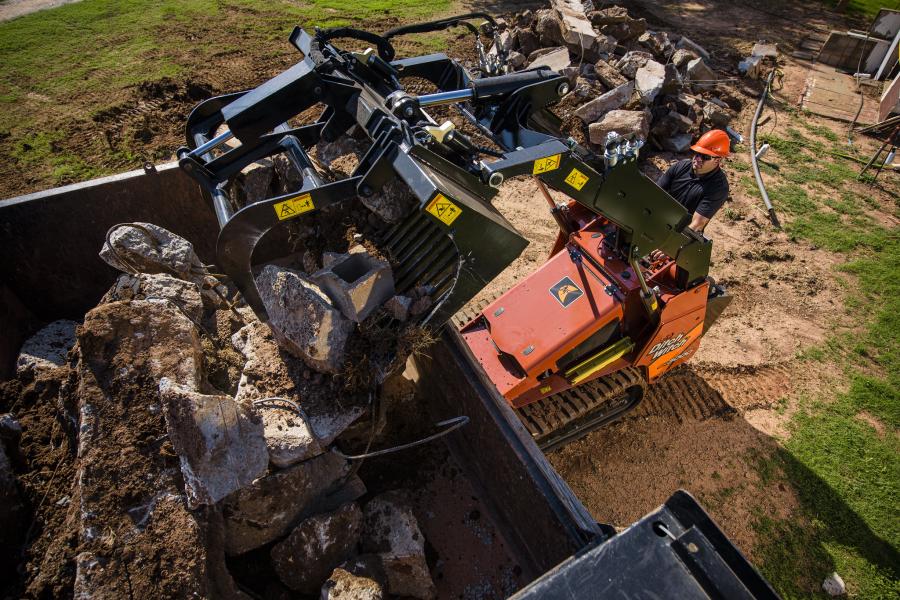When working with attachments, the standard rule of thumb is that a contractor should have three industry-specific attachments in their arsenal to succeed in a particular industry.
With the rising temperatures of the summer months comes the rise in demand for landscape, hardscape, tree care and other construction grade jobs. One of the biggest machine assets for operators in these spaces is a stand-on skid steer. Today's stand-on skid steers offer power, 360-degree visibility and simple maneuverability — all benefits that are keeping operators efficient on the job site.
But another benefit of a stand-on skid steer is the ability to equip a growing variety of attachments, which allows stand-on skid steers to be utilized in multiple jobsites tasks — and in some cases, multiple different industries. With the right attachment assortment, a stand-on skid steer can be a one-machine-solution.
When working with attachments, the standard rule of thumb is that a contractor should have three industry-specific attachments in their arsenal to succeed in a particular industry. For example, if a contractor is working in underground road work, they should consider investing in microtrenching attachments, coring attachments and vacuum-lifting attachments, in addition to the standard forks, buckets and grapples. This attachment variety will give them the ability to bid on the widest range of jobs in their preferred industry, and it will help keep them versatile and agile on the job site.
A Variety of Solutions
Stand-on skid-steers and the versatility of their attachments represent an opportunity for increased jobsite productivity. The ability to effortlessly switch out a variety of attachments allows operators to diversify their business without the overhead of investing in multiple different machines. Instead they can use one machine and invest in more affordable attachments.
From a trencher to a bucket, auger or fork, there are many attachments available that can help operators get the most ROI out of their stand-on skid-steer. Here a some of the most popular ones.
Buckets
Arguably the most popular attachment for stand-on skid steers, buckets help operators lift large piles of material or debris that need to be relocated or disposed of. There are a variety of bucket types to choose from, depending on application. For example, dirt buckets are primarily used for transporting topsoil and backfilling — making them ideal for a variety of jobs. While grapple buckets come with hydraulic clamps to hold unstable material, making them ideal for tree care or landscaping. There also are high-capacity buckets, buckets with teeth for digging and 4-in-1 buckets that are ideal for handling multiple projects on the job site.
Forks
Pallet forks are a staple for any stand-on skid-steer. The traditional attachment category is great for loading and unloading material from a trailer or truck bed and making material handling simple when traveling across tricky terrain. A pair of pallet forks can help operators move a variety of materials like sod, bricks, trees and ornamental garden boulders.
Trenchers
By using a trencher attachment, operators can complete trenching tasks without need of specialized trencher onsite. While individual trenchers have a place in the underground construction world, trencher attachments are great for operators looking to eliminate need of a second machine on the job. Ideal for landscape, plumbing and electrical projects, a trencher attachment can install everything from irrigation and drainage systems to electric, utility or fiber. Most trencher attachments are available in 4-, 6- and 8-in widths.
Vibratory Plow
Ideal for residential fiber installation, cable and lawn irrigation, a plow attachment delivers the most power and reliability on tight job sites. With two blades to choose from — the pull blade and feed blade — which can be adjusted between 6 and 24 in., vibratory plows offer a cost-effective solution that can meet fiber installation-depth requirements in various areas.
Rakes
Rake attachments will quickly become a landscaper's best friend. They are an ideal attachment to clean, level and prepare job sites. They also are a great tool to help smooth or loosen up soil for sodding or seeding tasking. The hydraulic requirements for most stand-on skid-steers to run a box rake are 10 to 14 gpm, but machines that boast higher hydraulic horsepower will provide even more drum torque to break up hardpack or clay soils.
Augers
Ideal for landscaping and tree care jobs that require multiple holes in the ground, an auger attachment will expedite creating holes, allowing operators to more quickly plant trees or install fence posts than if they were hand-digging or relying on hand-held augers. By speeding up these tasks, operators can take on more jobs in a day, increasing their ROI. Auger attachments are available in in a variety of bit styles and sizes which typically range from 6 to 36 in.
Microtrencher
Since microtrenching is typically done in the gutter pan which parallels the road, microtrencher attachments are designed to cut through both concrete and asphalt in controlled increments so contractors don't need to stop traffic. This saves on traffic redirection headaches and associated costs. Microtrenching is typically done in the gutter pan that parallels the road where the asphalt meets concrete of the curb.
There are two typical blades equipped in most microtrenching attachments. The first is a conical style bit that rotates in a holder and functions like a traditional rock saw. The second is a PDC blade which is composed of diamond with carbide. The conical bits are generally the more affordable option between the two, but diamond PDC blades are growing in popularity due to their cleaner cut and longer lifespan. While a conical bit will be effective from 500 to 1,000 ft. — meaning that contractors will likely need to replace bits daily — a diamond PDC blade will last up to 20,000 ft. before it needs to be replaced.
Today's top stories





















